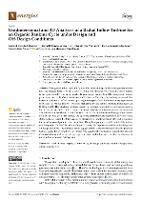Abstract
The organic Rankine cycle (ORC) is an efficient technology for electricity generation from
low- and medium-temperature heat sources. In this type of power cycle, the radial inflow turbine
is the option usually selected for electricity generation. As a critical ORC component, turbine
performance markedly affects the efficiency of the system. Therefore, the challenge is to model the
behavior of the radial inflow turbine operating with organic fluids for heat recovery applications.
In this context, various groups of fluids are highlighted in the scientific literature, including R-123,
R-245fa, and R-141b, which are the fluids used in this research. Since little research has focused on
the turbine efficiency effect on the power cycle design and analysis, this study presents an analysis of
a radial inflow turbine based on a mathematical model of a one-dimensional design of the turbine.
From this analysis, geometric, thermal, and operating parameters were determined, as well as volute,
stator, and rotor losses. For this purpose, an algorithm was implemented in MATLAB to calculate
the one-dimensional parameters of the turbine. Using these parameters, a 3D model of the turbine
was designed in ANSYS-CFX, with performance curves of each projected turbine under design and
off-design conditions. The numerical results suggest that the isentropic efficiency of all the proposed
turbines under design conditions can surpass 75%. Additionally, the findings indicate that different
design conditions, such as specific speed, pressure ratio, and turbine size, can affect the efficiency of
radial inflow turbines in ORC systems.














